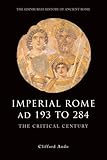Imperial Rome AD 193 to 284 : The Critical Century / Clifford Ando.
Material type: TextSeries: The Edinburgh History of Ancient Rome : EHARPublisher: Edinburgh : Edinburgh University Press, [2022]Copyright date: ©2012Description: 1 online resource (272 p.) : 23 B/W illustrations 4 MapsContent type:
TextSeries: The Edinburgh History of Ancient Rome : EHARPublisher: Edinburgh : Edinburgh University Press, [2022]Copyright date: ©2012Description: 1 online resource (272 p.) : 23 B/W illustrations 4 MapsContent type: - 9780748620500
- 9780748629206
- 900 22//gereng
- DG298 .A53 2012
- online - DeGruyter
| Item type | Current library | Call number | URL | Status | Notes | Barcode | |
|---|---|---|---|---|---|---|---|
 eBook
eBook
|
Biblioteca "Angelicum" Pont. Univ. S.Tommaso d'Aquino Nuvola online | online - DeGruyter (Browse shelf(Opens below)) | Online access | Not for loan (Accesso limitato) | Accesso per gli utenti autorizzati / Access for authorized users | (dgr)9780748629206 |
Frontmatter -- Contents -- Figures -- Series editor’s preface -- Acknowledgements -- Abbreviations -- Maps -- 1. A critical century -- 2. The principal author of the decline and fall -- 3. The legacies of Septimius Severus -- 4. Law, citizenship and the Antonine revolution -- 5. The empire and its neighbors: Maximinus to Philip -- 6. Religion -- 7. Failure and fragmentation: From the accession of Decius to the death of Gallienus -- 8. Government and governmentality -- 9. Reconquest and recidivism, 268–84 -- 10. Conclusion -- Emperors and usurpers -- Chronology -- Guide to further reading -- Works cited -- Index
restricted access online access with authorization star
http://purl.org/coar/access_right/c_16ec
GBS_insertPreviewButtonPopup(['ISBN:9780748620500','ISBN:9780748620517','ISBN:9780748629206','ISBN:9780748655359','ISBN:9780748655342','ISBN:9780748655359']);The Roman empire during the period framed by the accession of Septimus Severus in 193 and the rise of Diocletian in 284 has conventionally been regarded as one of 'crisis'. Between 235 and 284, at least eighteen men held the throne of the empire, for an average of less than three years, a reckoning which does not take into account all the relatives and lieutenants with whom those men shared power. Compared to the century between the accession of Nerva and the death of Commodus, this appears to be a period of near unintelligibility. The middle of the century also witnessed catastrophic, if temporary, ruptures in the territorial integrity of the empire. At slightly different times, large portions of the eastern and western halves of the empire passed under the control of powers and principalities who assumed the mantle of Roman government and exercised meaningful and legitimate juridical, political and military power over millions. The success and longevity of those political formations reflected local responses to the collapse of Roman governmental power in the face of extraordinary pressure on its borders. Even those regions that remained Roman were subjected to depredation and pillage by invading armies. The Roman peace, which had become in the last instance the justification for empire, had been shattered. In this pioneering history Clifford Ando describes and integrates the contrasting histories of different parts of the empire and assesses the impacts of administrative, political and religious change.Key features:Follows Rome's confrontation and conflict with a new world power, Sassanian Persia, in which two Roman emperors lost their livesDevotes special attention to legal historyExamines the changing nature of religious pluralism and the Christian persecutions"
Mode of access: Internet via World Wide Web.
In English.
Description based on online resource; title from PDF title page (publisher's Web site, viewed 29. Jun 2022)


